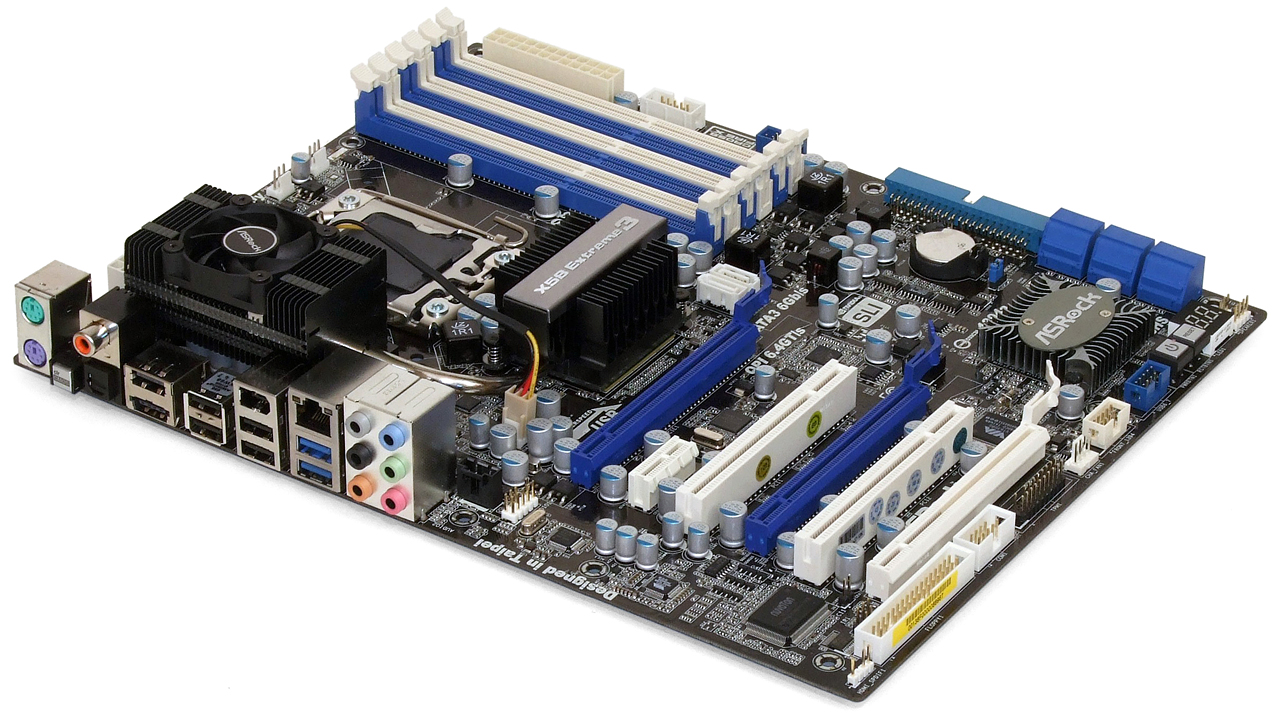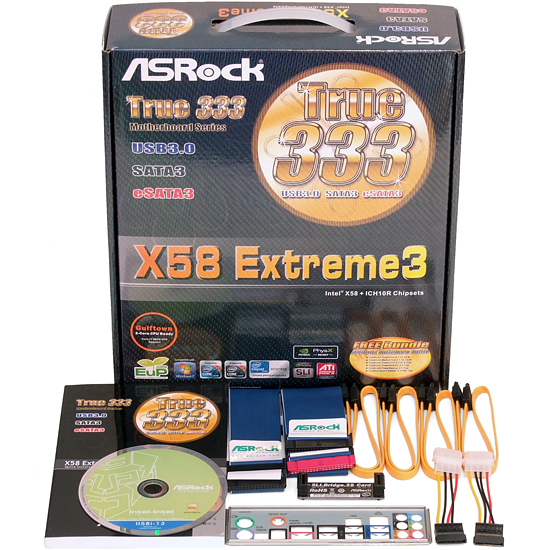X58 In 2010: Four LGA 1366 Boards With USB 3.0 And SATA 6Gb/s
The March 2010 launch of Intel's hexa-core Core i7-980X gave us a good reason to revisit the LGA 1366 interface. Today, we're looking at four new X58 Express-based motherboards that tie USB 3.0 and SATA 6Gb/s support in to Intel's flagship platform.
ASRock X58 Extreme3
ASRock produces two USB 3.0-equipped X58 models, but its X58 Extreme3 is the only version to use onboard controllers rather than x1 cards. Like the other boards in today’s comparison, it also includes the future-looking SATA 6Gb/s controller. If you can't find this board online, trying searching for it as the “X58 Extreme 3."
The X58 Extreme3 provides a third x16-length slot, in addition to its two PCIe 2.0 x16 slots, but that the third slot is not PCIe 2.0-compliant. The third slot instead uses four of the chipset’s PCIe 1.1 lanes, making it too slow for performance graphics use. This configuration allows two of the chipset’s four remaining PCIe 2.0 lanes to serve the USB 3.0 and SATA 6Gb/s controllers. Yet, while performance considerations limit the X58 Extreme3 to dual-card SLI or CrossFire configurations, at least ASRock puts an extra space between its two full-performance x16 slots to improve airflow between cards.
Priced at only $200, the X58 Extreme3 is one the few “low-cost” X58 motherboards to incorporate bench-top-friendly onboard power and reset buttons, in addition to an overclocker-friendly Port 80 diagnostics display.
ASRock appears to be the only company in today’s roundup to notice that the Marvell 88SE9128 PCIe to SATA 6Gb/s controller also supports a single Ultra ATA interface, as the X58 Extreme3 is the only product to utilize it. The X58 Extreme3 also taps into the keyboard (Multi I/O) controller’s floppy and serial port functions, but neglects its integrated parallel port function. One might argue about the value of any legacy connectors, but we can still appreciate ASRock’s attempt to make the most of the motherboard’s built-in capabilities.
Unfortunately, the X58 Extreme lacks any additional controller for eSATA and instead relies on the same 88SE9128 that provides two SATA 6Gb/s connections internally. The second internal port is shared with the external port, so that using it internally forces the user to sacrifice the rear-panel port.
Another blast-from-the-past is the 40 mm VRM cooling fan, a part that spins at such low speed as to produce almost unnoticeable noise. This particular part could be handy when using cross-flow CPU coolers that mostly miss the motherboard’s sinks, but a higher-airflow fan might be required in highly-overclocked liquid-cooled systems.
The X58 Extreme3 has a few pleasant surprises in the area of cable management, with USB 2.0 and front-panel LED connections at the motherboard’s front-end for easy to reach top-panel bays. Similarly, the front-panel audio cable has been moved several inches from the board’s traditional bottom-rear-corner location, and now resides above the uppermost PCIe x16 slot, allowing easier reach using the short cables that come with some cases. The internal FireWire header is still found at the bottom edge however, though it at least has been slid forward of the bottom PCIe slot.
Get Tom's Hardware's best news and in-depth reviews, straight to your inbox.
BIOS Features
ASRock OC Tweaker provides a wide enough range of controls to overclock most hardware to its limit, if desired. This begins with “CPU EZ OC Setting” and “DDR3 EZ OC Setting” profiles to assist neophytes in their performance-chasing endeavors.
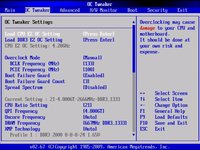
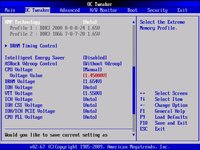
Scrolling past a fairly complete frequency selection brings us to a similarly-complete voltage control set. Further down the main menus are three registers where custom overclocking profiles can be stored.
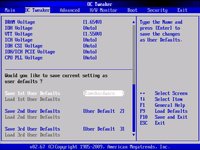

The DRAM Timing Control submenu provides a more modest set of timings, but there’s still enough here for most tuners. Individual settings can be left in “Auto” mode if desired.
Accessories
With two high-bandwidth PCIe 2.0 x16 slots, the X58 Extreme3 requires only a single SLI bridge to serve the needs of most Nvidia users. CrossFire support comes by way of the bridge included with most Radeon graphics cards, while the remainder of ASRock’s installation kit includes six SATA cables, an Ultra ATA cable, and even an old-fashioned floppy cable.
-
Tindytim First Intel punishes me by not releasing a proper 32nm 920 replacement for the 1366, and then Tom's publishes this article only days after I purchase components for yet another 1366 build.Reply
I must be a BYOPC masochist. -
Stardude82 Nice to see that mobo makers aren't charging too much of a premium for USB 3.0 and SATA-6. On the other hand, what an embarrassing for ASRock just as I thought they were getting out the shadow of ASUS.Reply
I would have liked to see those new ports put to use on these boards... -
omoronovo I very recently decided to take the plunge in an i7-based build, and I chose the UD3R for it. I couldn't be happier - this little monster pushes my i7 to 4ghz stable on stock vcore.Reply
One thing I haven't seen anywhere though, but would like to, is the overclocking variance added through differing ram capacities. Even though I reached 4ghz on stock vcore, I had to push my QPI to 1.35 to keep the system stable with 6 modules installed. With 4 modules, this was reduced to 1.28, and with 3 it was around 1.24 and with only 2 I could run the QPI volts at 1.2.
Perhaps an idea for an in-depth article at some point in the future Toms? -
liquidsnake718 Thank you TS. I think you may have built and benched my new computer. I see you still chose the 920 over the 930. Even before reading this article, I had my eyes on the UD3R because of the price and the decent features, save the sound card. However because of this article, I am going to reserve this mb and start building a newbie!Reply
The next step would be to see how these boards stack up using 6 cores and letting people know what power with 6 cores means using a 1 & a half year old motherboard. Although knowing that 6 cores, USB3.0 and SATA 6.0gb are a long way from being standard, it is by no means premature to have this board as one knows that they will be paying and buying for the long haul! The smartest ones do, and seeing as you guys chose the best parts for the price in terms of quality/performance, the UD3 is a perfect fit for a 5850 or maybe 2!
You should send this article to someone at Intel and maybe they will want to soon follow the way of USB3.0 for their vanilla board! I guess these builds are the new standard for high end or borderline excellent.
-
anders_w An error/typo in the table page 2?Reply
http://www.tomshardware.com/reviews/x58-usb-3.0-sata-6-gbps,2614-2.html
The table claims Asus P6X58D-E have Chipset S-ata 6 x SATA 6.0 Gb/s
Should probably be 6 x SATA 3.0 Gb/s... -
Crashman anders_wAn error/typo in the table page 2?http://www.tomshardware.com/review 614-2.htmlThe table claims Asus P6X58D-E have Chipset S-ata 6 x SATA 6.0 Gb/sShould probably be 6 x SATA 3.0 Gb/s...Reply
Thanks. -
C 64 At first quick look at the picture I almost fell from my chair... a quad processor MB, but then I realized Tom had problems squeezing the MBs in the pic.Reply
-
Crashman zipzoomflyhighAnother X58 reviews. Just what we all wanted. NOT.Yeh, X58 is obviously exceeds your needs but there hasn't been much news on the Via Apollo Pro front.Reply -
abhishekk89 i'd been planning on a p55 chipset + i5 750... now i'm thinking of i7 930 + gigabyte ud3rReply
